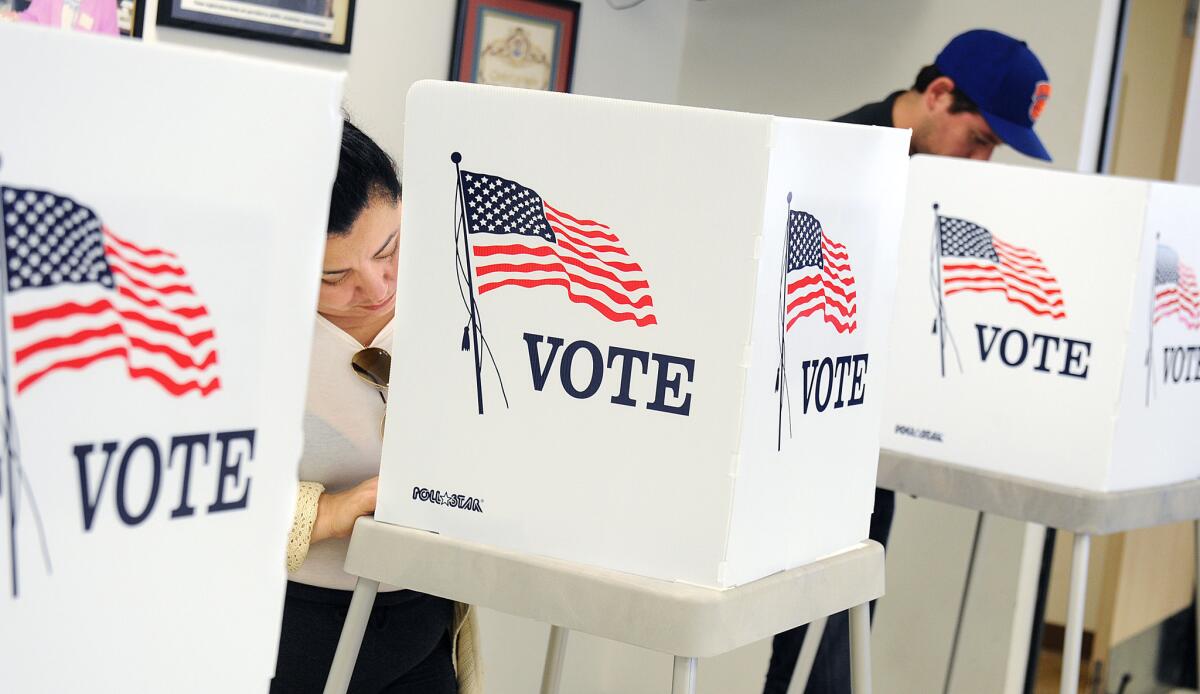That blockbuster California ballot will be a $452-million battle

- Share via
Reporting From Sacramento — In an election year in which Californians, by virtue of the state’s relative insignificance in the presidential campaign and a fairly tepid U.S. Senate race, have been spared the brunt of nonstop politicking, political experts say the storm is coming.
“We’re going to have a deluge of political ads, of all forms,” said Ned Wigglesworth, a Sacramento-based campaign strategist whose firm has done an early projection of what will be spent on statewide ballot measure campaigns this fall.
The bottom line: an initiative season in the Golden State that could see total spending of at least $452 million — and perhaps even hitting half a billion dollars — by the time the final votes are cast.
Join the conversation on Facebook >>
For months, California’s ballot initiative industry has been watching that so-called perfect political weather system brewing, courtesy of what’s expected to be the biggest crop of statewide measures on a single ballot in more than a decade. To date, eight measures have qualified for the Nov. 8 ballot. Interviews over the past week with campaign consultants who specialize in initiatives say an additional 15 viable measures remain in circulation to gather the voter signatures needed to qualify.
“I would have thought by now that it would have thinned out,” said Gale Kaufman, a veteran Democratic campaign consultant.
Though a 2014 law signed by Gov. Jerry Brown allows proponents to withdraw their initiative after negotiations with the Legislature, none of the backers of this year’s proposed ballot measures appear ready to lay down their arms. The first legislative hearing on a proposed ballot initiative, one that could threaten Brown’s plans for underground water tunnels through the Sacramento-San Joaquin River Delta, is scheduled for early next month.
The list of viable ballot measures includes an effort to fully legalize marijuana, new taxes on tobacco and extended taxes on wealthy Californians, and issues ranging from gun control to new rules on legislative procedures and disclosure for government lobbying.
It also includes two potential measures seeking to do the same thing: raise California’s minimum wage. One of those initiatives, sponsored by hospital workers affiliated with the Service Employees International Union, has already turned in its signatures; it would raise the wage over four years to $15 an hour with annual inflation adjustments after that.
“One way or another, we support raising the minimum wage,” said Steve Trossman, a spokesman for the hospital workers union.
See the most-read stories this hour >>
A rival measure, written by SEIU’s statewide council, would match that minimum wage increase while also boosting the number of state-mandated paid sick days. Neither union group appears ready to back down, raising the possibility that voters could be asked to weigh two different initiatives on the same subject.
“Our campaign is moving full steam ahead, with paid and volunteer signature gatherers in the field as we speak,” said Laphonza Butler, president of the statewide union.
The specter of a super-sized ballot this fall leaves campaign professionals unsure of exactly how California voters will make sense of the complex issues in front of them.
“When you get stuck in this kind of cacophony, it becomes much harder to game out how that’s going to play,” Wigglesworth said.
And those campaigns with the most money have the best chance at being heard. State campaign finance records show almost $70 million has already been raised or spent for November ballot initiatives. One of the largest war chests is held by the pharmaceutical industry, with more than $38 million for fighting against an initiative to cap prescription drug prices paid by state health agencies, a major drug purchaser that could influence overall prices.
One big factor in both how many propositions appear on November’s ballot (and thus the total money spent) will be the cost to gather signatures.
“I’ve never seen it like this,” said Kaufman, as the independent contractors who circulate initiative petitions have fought withstood rainy weather and storefront bans on signature gathering. As a result, some consultants believe campaigns will be paying as much as $6 per voter signature by the middle of March.
Perhaps the most notable reason for the long and costly political season ahead may be that initiative measures no longer appear on the June statewide primary ballot. Under a law signed by Brown in 2011, initiatives are lumped together in November. At the time, advocates of the law said it would ensure that important policy choices were weighed during general elections where voter turnout is usually higher.
But this year, it also means that a long and expensive campaign season — replete with thousands of television ads, mailers, and digital messages — is just around the corner.
“Is this the quiet before the storm?” said Wigglesworth. “Oh, yeah.”
Follow @johnmyers on Twitter, subscribe to the California Politics Podcast and sign up for our daily Essential Politics newsletter.
ALSO
California’s November ballot could be a blockbuster
Follow what’s happening in Sacramento
More to Read
Sign up for Essential California
The most important California stories and recommendations in your inbox every morning.
You may occasionally receive promotional content from the Los Angeles Times.














